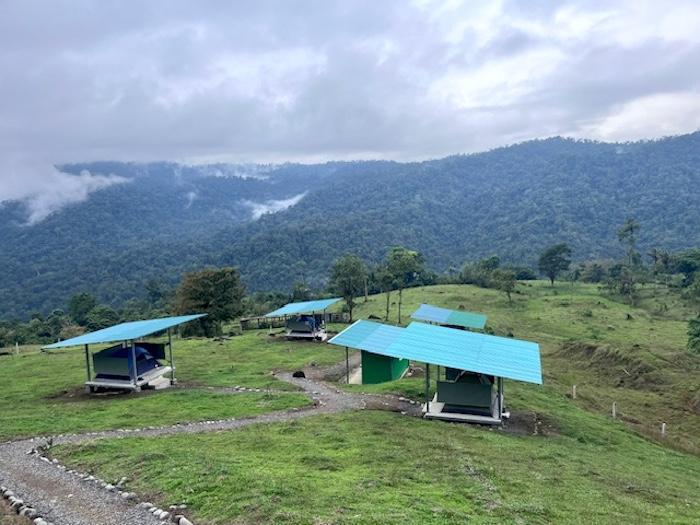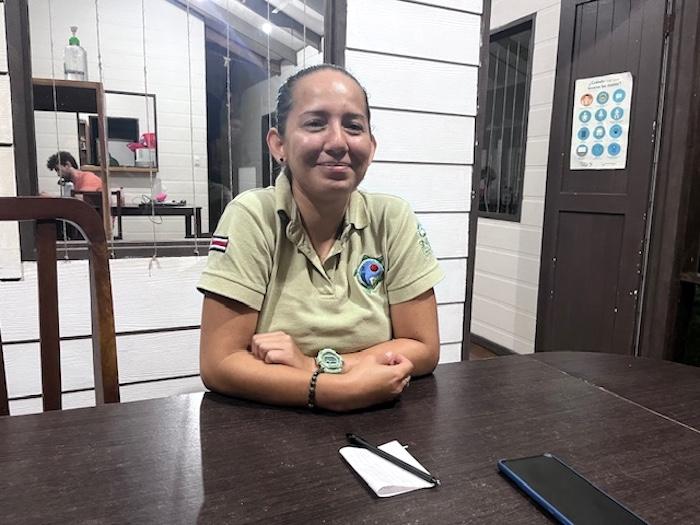
Manuel Antonio National Park is Costa Rica's most visited, but it struggles with staffing/Tiffany Masterson via Pixabay
Despite Its Environmental Consciousness, Costa Rica Struggles To Keep Faith With Its Conservation Ideal
By Rita Beamish
QUEPOS, Costa Rica – Costa Rica is famous for safeguarding its richly biodiverse lands, among them 30 national parks, which it justifiably promotes as a tourist draw. Overall, some 25 percent of the small Central American nation is under protected status, including parks, wildlife refuges, biological reserves, national wetlands and forest zones.
Trekkers who walk across the country on the “Camino de Costa Rica,” plying leafy paths and small dirt roads through jungle and cloud forest, coffee fincas, sugar plantations and Indigenous terrain, have a special window into some of these lands.
Along the route from the Caribbean to the Pacific, two national parks touch the Camino directly, Barbilla and Tapanti. Other parks loom in the distance, and the country’s busiest, Parque Nacional Manuel Antonio, is just over four miles south of the town of Quepos, the Pacific Coast terminus of the Camino.
Together these and the other protected lands have a mission to protect some of the world’s most celebrated and significant biodiversity. From gigantic sea turtles to endemic orchids and forests with a warble soundtrack — the laughing falcon’s two-tone “ha-ha,” the ornate hawk-eagle’s caw — Costa Rica’s natural world is a major economic driver.

Tent platforms along the Camino de Costa Rica let you gaze into Barbilla National Park/Rita Beamish
Its suite of environmental laws wins plaudits in green circles: a hunting ban, logging restrictions, and a nationwide conservation zone system among them. Through a concerted effort, the country notably reversed decades of dramatic deforestation, although illegal logging does still occur.
Even Costa Rica’s multipurpose slogan, “Pura Vida” — spoken in greeting, farewell, and general celebration of chill good-vibes and well-being — infers an appreciation of the country’s natural bounty. But a look beneath the surface reveals ongoing struggles to keep faith with the nation’s conservation ideal even as its ecotourism flourishes.
- Park officials struggle with startlingly small staff numbers and say they need more resources to manage their vast portfolios.
- Protected lands are beset by human-caused fires, illegal hunting and mining, and poaching of rare species.
- Parks grapple with weighing tourist access against protecting resources from destructive human impacts.
Environmental advocates appreciate the country’s legal safeguards and its recognition of environmental problems, but worry about the urgency needed to sustain protective measures.
“The reality is we have this terrific system in place. We have the law, we have a ministry, and a system of protected areas in the country. But they are suffering for lack of money, a lack of resources” for implementation and enforcement, said Max Villalobos, who manages the Central America programs of Global Conservation, a nonprofit that provides logistics, training, and equipment to help reign in illegal forest activities.
“We still have problems. We are trying to solve them,” he added in an interview with the Traveler. “The whole system is very strong from the legal point of view. But the problem we are facing now in the protected areas is the capacity to be operative with these regulations.”
The agency that oversees protected lands, the National System of Conservation Areas, known by its Spanish acronym SINAC, acknowledges staffing shortages in the parks. “The current administration considers that the number of park rangers is especially low, and is requesting an increase in personnel for the parks, which is still under negotiation,” spokesman Álvaro Conejo Arias told the Traveler in an email.
“The parks are understaffed because the state has faced a very high fiscal deficit in recent years, which forced it not to create new positions,” except some in security and education areas, he said. “This resulted in the non-replacement of employees retiring from the parks and other sectors.”
Rangers Do It All
The days are long for the handful of rangers at Barbilla National Park, which sprawls across 30,000 acres of wet tropical forest on the flanks of the Talamanca range, the highest and wildest non-volcanic mountain range in Central America, according to UNESCO. Traditionally the home of the Indigenous Cabecar people who still live in the surrounding area, the park hosts a long list of native species including jaguars, ocelots, tapirs, monkeys and rare birds. It is part of the binational La Amistad Biosphere Reserve in Costa Rica and Panama. An adjacent camping area was a recent overnight stop for a small Camino hiking group visiting Barbilla, including two Traveler correspondents.

Barbilla National Park Administrator Diana Cordero Chacón makes do as best she can with limited staff/Rita Beamish
Reached via a bumpy unpaved road, Barbilla has just a few muddy kilometers of trails, and draws only about 50 or 60 visitors per month, according to park Administrator Diana Cordero Chacón. Ostensibly a paltry flow, that is a lot from where she sits. That’s because the entire park staff consists of five people, including herself. When accounting for days off and staff emergencies, only a couple may be on duty many days, she said in an interview at Barbilla’s humble, wooden ranger station.
It was after dark on a recent day when the administrator returned to the station after a long day of tending to duties miles outside park borders — among them, retrieving an injured bird from police and taking it to a rescue center, and collecting a ranger colleague who needed a ride back. A lone staffer had remained at the station, which has open-air corridors and staff living quarters, to answer phones, clean bathrooms, and handle ticket sales and office work. Another ranger was deep in the woods with a university researcher studying wildlife sounds as a window into forest health.
The staff also conducts outreach with neighboring Indigenous communities and responds to outside-the-park issues such as nuisance wildlife and environmental violations. “It’s part of what we have to do,” said Cordero Chacón. Meanwhile, she said, “I don’t have the personnel to patrol the borders of the park” to thwart poaching and other illegal activity. “Some people are coming every weekend and taking animals out to sell to restaurants.”
With more staff, she said, she could monitor and protect rare species and root out illegal logging and squatting. She said is grateful that some Indigenous people patrol their own nearby lands because that helps protect park ecosystems, too.
“I want to do environmental education,” to raise awareness about protecting natural resources, she continued, “but I don’t have the materials the equipment to do it.”
Tourist Overload
The Pacific Coast park of Manuel Antonio has a staffing crunch also, one linked to its popularity. It is the most-visited national park even though it is the smallest in Costa Rica — 4,900 acres of forest and more than 60,000 marine acres. More than 476,500 visitors walked through its gates last year, park Administrator Francisco Jiménez Quirós, told the Traveler. They flock to the park’s sparkling beaches and throng the limited forest paths, often clustering around tour guides who tote telescopes to ensure visitors see sloths, rare birds, and other wildlife that camouflage themselves high in the trees.
The park has 14 staff members in all, the administrator said. They work 10 days, followed by five days off, meaning sometimes only five or six people are available to staff the entry gates, do maintenance and administrative work, patrol for poachers and illegal entrants, handle offsite calls, and everything else, he said in an interview at his small office near where long lines of ticketed tourists were being processed through the entrance security checkpoint.
More financial resources could help get to priorities like monitoring the park’s seacoast and investigating the status of plant and animal health, said Jiménez Quirós.
Roy Salazar, officially an environmental education ranger, said he is more typically involved in other park duties. The previous day when a brush fire erupted in the park, “I had to put it out,” he said.
The ecological impacts from the tourist masses led the country’s Constitutional Court in May 2023 to order a daily cap of 1,120 visitors, down from 3,000. The court noted a lack of scientific research to prove that visitor pressure was not burdening the ecosystem.
“The biggest threat for conservation in the park is tourists and lack of park rangers. The park is receiving more people than the environment and animals can support,” said Laura Porras Murillo, a biologist at University of Costa Rica’s International Institute for Conservation and Wildlife Management who has studied the park for years.
Her research in 2012-2020 found racoons and other animals had shifted from nocturnal activity to daytime when tourists and their snack foods were around. By contrast, during the park’s pandemic closure period, animals returned to normal activity in early morning and late day.

Costa Rica-Manuel Antonio National Park Administrator Francisco Jimenez Quirós (left) and park ranger Roy Salazar/Rita Beamish
Bringing food into the park is now strictly forbidden, but educating tourists about animal safety appears to be an uphill effort. On two recent consecutive days along the Manuel Antonio boundary, two different tourist couples coaxed monkeys to their outstretched hands with food. One incident occurred just steps from a sign that forbade the practice. When a passerby pointed out that the feeding was not allowed, the scofflaws in both cases shrugged and continued the offense.
After last year’s court ruling, President Rodrigo Chaves noted the park’s importance to the economy, and promised millions of dollars in investment to handle more tourists, media accounts said.
After improvements were made to some trails and structures, the daily visitor limit now is up to 1,806, according to Conejo Arias.
But Porras Murillo noted some trails are still closed. She said a detailed study to assess soil and water contamination and other impacts is needed to ascertain appropriate visitor numbers and staffing needs.
NGO Help
Conservationists’ concerns over the need for enforcement patrols prompted Jeff Morgan, founder and executive director of Global Conservation, to develop a patrol assistance program. It provides surveillance technology, logistics, and other support, including training of local people who can help with park duties while rangers are conducting enforcement activities.
“For a country that’s supposed to be the No. 1 green country in Latin America, it’s just kind of disappointing to see the level of resources available for protection and scientific monitoring,” said Morgan.
He described accompanying a patrol in sprawling Corcovado National Park, where hundreds of illegal gold miners are said to operate. Illegal hunting of white-lipped peccary, a pig-like animal, also is problem and deprives jaguars of a key source of prey.
The patrol found a 100-foot-long structure containing a fire for drying hundreds of animal carcasses, he said. “They were drying the meat so they can sell it to the market,” said Morgan, adding that the meat is a pricey but in high demand.
Researchers believe jaguars are in decline at Corcovado, with their numbers estimated at just 30 to 35 in a 2007 report. But a more rigorous methodology is needed for a true picture, said Juan Carlos Cruz, a wildlife biologist and jaguar expert who works with nonprofits Namas Conservation and Amazon Conservation Team. The study is planned for this summer, he said.
At Barbilla National Park, it’s impossible to know whether jaguars might be verging on extirpation, because no one sees them, said Administrator Cordero Chacón. “To know if I don’t have cats, I have to have research,” she said.
Illegal hunting, logging and mining are continuing problems in SINAC’s view “but they are becoming less and less important,” Conejo Arias said. “More thought is being given to other problems that also affect the parks, such as water pollution and forest fires, since they are also affecting the populations surrounding the protected areas.”
Wildfires pose a particular risk in this year’s El Nino conditions. SINAC’s fire management coordinator, Oscar Mora, in a social media post called it a “critical year for our ecosystems.”
Officials say more than 98 percent of fires are human-caused from agricultural burning, arson, vandalism, and tourist negligence. In Irazu National Park, an illegal tourist bonfire was blamed for a March blaze that threatened thousands of native species before firefighters contained it to under three acres; and hunters were faulted for a recent blaze in Carara National Park. Hunting is banned in Costa Rica.
Promise And Challenge
For all its challenges, Costa Rica has achieved examples of notable success, as with Guanacaste Conservation Area, which includes three national parks in the northwest, Cruz said. The area’s tropical dry forest was restored thanks to years of concerted efforts involving scientific work, political will, and land management, after many decades of logging and pasture-clearing, he said. Jaguars have recovered from near extirpation to a healthy population.
“It is one of the success stories in Costa Rica’s long journey for conservation and to become a great country,” Cruz said.

Add comment